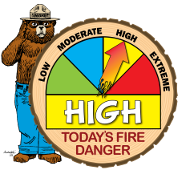Weekly Safety Message
🔥 Important Fire Update from Silverton Fire 🔥
Dear Silverton Community,
We are pleased to share some positive news regarding our current fire danger level. The fire danger in our area has been downgraded from Extreme to High. 🙌🌲
This is a testament to the hard work and dedication of our incredible firefighters, emergency responders, and all those who have supported our efforts. We are immensely grateful for your cooperation and vigilance during this challenging time.
While this downgrading is a step in the right direction, please remember that fire safety should still be a top priority. Continue to adhere to local fire restrictions and follow safety guidelines to ensure the well-being of our community.
Here are a few important reminders: 👉 Adhere to all local fire restrictions and regulations. 👉 Maintain a defensible space around your property. 👉 Dispose of cigarettes and matches responsibly. 👉 Be prepared with an emergency kit and evacuation plan.
We remain vigilant and prepared for any changes in the fire situation, and we will continue to keep you updated. Your safety is our utmost concern.
Thank you for your continued support, resilience, and community spirit. Together, we are strong! 💪
Stay safe, Silverton! ❤️🏡🌿

